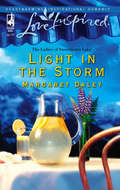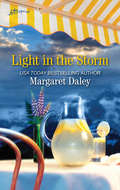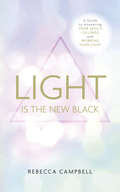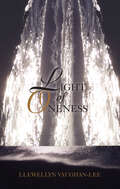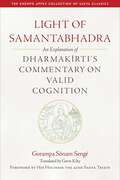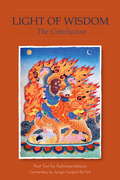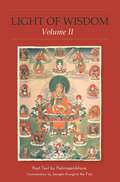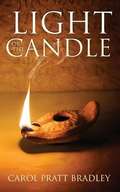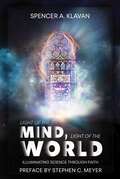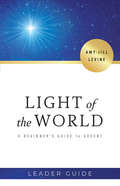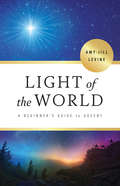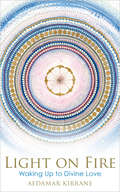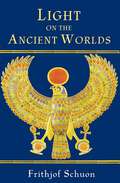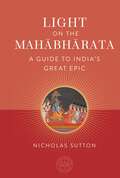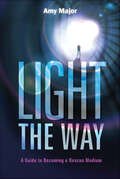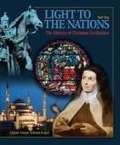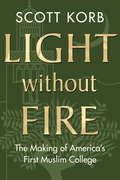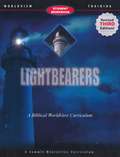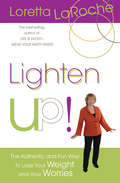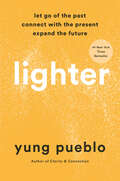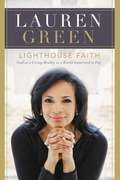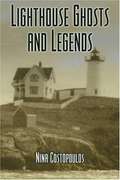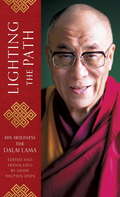- Table View
- List View
Light in the Storm
by Margaret DaleyGOLD IN THE FIREOn the job firefighter Joshua Markham has no problem taking risks, leaving his fate in God's hands. But opening his heart to young widow Darcy O'Brien requires a far greater leap of faith. LIGHT IN THE STORMAfter years of putting herself last, Beth Coleman is finally ready to fulfill her long-cherished dream of seeing the world. Then the unexpected arrival of Samuel Morgan and his three children makes her question which path she is truly meant to travel.
Light in the Storm
by Margaret DaleyJourney of the Heart After raising her three siblings, high school teacher Beth Coleman is finally, at thirty-eight, responsible for herself alone. With her nurturing nature, she loved caring for her family, but now she can travel, see the world. Her only decision? Where to go. Yet as Beth ponders South America as her first stop, a troubled teen walks into her classroom, and with her, a single dad—a handsome, kind, caring man to boot. Though Beth tries to deny it, Samuel Morgan and his ready-made family begin to win her heart. South America awaits, but so does Samuel...and the new family she wonders if she’s willing to risk losing. Originally published in 2005
Light is the New Black: A Guide to Answering Your Soul's Callings and Working Your Light
by Rebecca CampbellAn encouraging guidebook to awaken to your potential, connect with the callings of your soul, and light up the world with your presence.This international bestselling book has helped hundreds of thousands of people all over the world to create a life that is in deep alignment with their soul."Light Is The New Black is an inspiring book with a message that is so needed right now. Rebecca courageously guides us to turn our lights on and follow the daily calls of our soul so we can all light up the world with our authentic spirit.&” – Sonia Choquette, bestselling author of The Answer is SimpleANSWER THE CALL OF YOUR SOUL AND WORK YOUR LIGHTYour inner light is your soul and it is guiding you every moment of every day. Light Is the New Black is for those who agreed to be here at this time in history to answer the call of their soul and work their light.Rebecca Campbell had her first awakening when she was a teenager, but without anyone to guide her, she ignored her soul's callings and dimmed her light in order to fit in. Then, just before her 30th birthday, the life she had so consciously created began to crumble around her.It was as if the Universe had turned off all the lights, so she had no choice but to rediscover her own.In this inspirational book, Rebecca shares her own healing journey, alongside practical tools to help you reconnect with the core of your being, and channelled messages from the Universe.Once you rediscover what you already know at soul level, you can create a life that is in divine alignment, discover your soul gifts, and offer the world something that only you can give.&“When I first woke up to the callings of my soul, I lacked the courage, confidence, inner support, and practical tools not just to hear the callings of my soul, but to let them truly lead my life.There were pieces missing, a journey needed to be taken. I called upon the Universe and spiritual teachers to support me. This book is the result of that journey.You can read it in one sitting, one chapter a day, or pick a page at random for an instant hit of guidance. Throughout you will find &‘Work Your Light&’ exercises, mantras, and affirmations.I created these with the intention of guiding you not only to hear the callings of your soul, but to act on them too...I pray that you discover the authentic gift to the world that you already are and choose to serve the world by being You. Follow what lights you up and you will light up the world.So much love,Rebecca x
Light of Oneness
by Llewellyn Vaughan-LeeExploring how humanity is awakening to the consciousness of oneness—an awareness of the unity and interconnectedness of all life—this book delves into this hidden dimension of mystical life, expanding the understanding of spiritual work and the potential for global transformation. It shows how mystics are helping with this work, bringing light and love where it is needed, transforming old patterns, and bringing this new awareness into the mainstream. This book stresses the role of the feminine and how her natural understanding of life's wholeness and interrelatedness is pivotal to evolution, offering an understanding of a future in which the knowledge of science and the wisdom of the mystic will come together.
Light of Samantabhadra: An Explanation of Dharmakirti's Commentary on Valid Cognition
by Gorampa Sönam SengéAn illuminating gateway to Indian philosophy and its explication in Tibet.Among the many works produced in the rich philosophical tradition of India&’s classical age, few have had more impact than Dharmakirti&’s Commentary on Valid Cognition (Pramanavarttika). Composed in India in the seventh century, it became the cornerstone for the study of logic and epistemology in the Tibetan Buddhist tradition. An important addition to any collection for the Sakya practitioner, Light of Samantabhadra translates the work of one of the premier scholars of the Sakya school, Gorampa Sonam Sengé (1429–89). Gorampa here illuminates the first two chapters of Dharmakirti&’s treatise, those on using inference to enlighten oneself (svarthanumana) and on establishing valid cognition (pramanasiddhi), both to determine the authority of the Buddha as a valid teacher and to eliminate the cognitive obstacles to awakening. The root text is composed in compact verses, and these are translated here along with Gorampa&’s word-by-word commentary that reveals their often-veiled meanings. These chapters explore key issues in the philosophy of language and the nature of conventional designation, the way to employ sound reasoning, the proof of past and future lives, and the way to eliminate the view of self. In the skilled hands of translator Gavin Kilty, these insights are made accessible to contemporary readers.
Light of Wisdom, The Conclusion
by Jamgon Kongtrul Padmasambhava Guru Rinpoche Chokgyur Lingpa Jamyang DrakpaThe Light of Wisdom, the Conclusion, presents detailed explanations of the activities of a Vajra Master and Buddhist practices to clear away hindrances on the path and enhance realization. The book is a combination of three texts:The root text, The Gradual Path of the Wisdom Essence is oral instructions of Padmasambhava, recorded by his chief female disciple, Yeshe Tsogyal. Padmasambhava established the Buddhist doctrine in Tibet during the eight century. He concealed teachings in the form of hidden treasures, to be revealed at an appropriate time in the future. The Light of Wisdom by Jamgön Kongtrül, one of the most prominent Buddhist masters of nineteenth-century Tibet, is an extensive commentary on this sacred scripture. Entering the Path of Wisdom consists of annotations on the commentary by Jamyang Drakpa, a student of Jamgön Kongtrül, dictated to Jokyab Rinpoche.The root text of Lamrim Yeshe Nyingpo, a terma revealed by the great treasure-finder Chokgyur Lingpa, and its commentary by Kongtrül Rinpoche, the great translator in person, form together a complete scripture that embodies all the tantras, statements and instructions of the Nyingma School of the early translations, which is most rare to find in the past, present, or future. ...I find it important that all Dharma practitioners study and reflect upon this book.? Kyabje Dilgo Khyentse RinpocheIt is correct that it will be quite difficult to practice the entire Gradual Path of the Wisdom Essence, so you should use what is directly appropriate for your training. It is never said that you should practice an entire root text as Light of Wisdom contains the complete path for different kinds of individuals, both of Hinayana, Mahayana and Vajrayana. But since its title is the Wisdom Essence, it means that its ultimate practice is Dzogchen.? Kyabje Tulku Urgyen Rinpoche
Light of Wisdom, Volume II
by Padmasambhava Guru RinpocheLight of Wisdom, Volume II contains the root terms -hidden treasure text - of Padmasambhava, The GradualPath of the Wisdom Essence and its commentary TheLight of Wisdom by Jamgön Kongtru¨l the Great. Annotationson the commentary Entering the Path of Wisdom spokenby Jamyang Drakpa and recorded by Jokyab Rinpoche areincluded as well as clarifications from other masters.Volume II presents in-depth explanations of the VajrayanaBuddhist perspective. It begins with the nature of empowermentand the tantric commitments followed by clarification ofthe development stage.
Light of the Candle
by Carol Pratt BradleyAs a young nobleman at the court of Jerusalem, Daniel's life is one of privilege. His childhood friend, Sarai, is betrothed to him. Sarai's future also stretches securely before her. She will marry the boy she loves and they will live together in their beloved homeland.<P><P> But outside the city gates waits Judah's conqueror, Nebuchadnezzar, prince of Babylon, who demands a heavy price for peace. He takes treasures from the great temple of Jerusalem and hostages from among the promising young scholars, who will serve him in the court at Babylon.<P> Daniel's dreams are filled with strange images of things he has never seen. When Daniel's father ensures that he is one of the young men selected, the dreams become frighteningly real.<P> The prophet Jeremiah's dire warnings have come to pass for Daniel, Sarai and for all of Judah--The voice of mirth and gladness are taken; the voice of the bride and bridegroom, and the sound of the millstones and the light of the candle.<P> Sarai in Jerusalem and Daniel in Babylon will face the same challenge: to keep hope bright as darkness closes in.
Light of the Mind, Light of the World: Illuminating Science Through Faith
by Spencer KlavanThe world is not a machine. Humanity is not a mistake. For centuries, a grim anti-human outlook has taken hold of the public imagination, teaching us all to view ourselves as random products of a cruel and uncaring natural world. Today, from apocalyptic environmentalism to twisted eugenics and dystopian bionic augmentation, movements are rising around the world to dispense with humanity or subordinate it to a pitiless mechanical logic. For many, it has come to seem as if the human spirit is obsolete, religious faith is illusory, and mankind is destined to be extinguished or surpassed. Some might even see the end of humanity as a good thing. But that is not our future. Light of the Mind, Light of the World tells a daring new story about how we got here, and how we can chart a better path forward. Surveying the history of science and faith from the astronomers of Babylon to the quantum physicists of postwar Europe and America, classicist and scholar Spencer A. Klavan argues that science itself is leading us not away from God but back to him, and to the ancient faith that places the human soul at the center of the universe. Reconciling the discoveries of science with the truths of the Bible, Klavan shows how the search for knowledge of the natural world can help illuminate the glories of its Creator, and how the latest developments in physics can help shatter the illusion of materialism.
Light of the World Leader Guide: A Beginner's Guide to Advent (Light of the World)
by Amy-Jill LevineIn Light of the World: A Beginner’s Guide to Advent, author, professor, and biblical scholar Amy-Jill Levine explores the biblical texts surrounding the story of the birth of Jesus. Join her as she traces the Christmas narrative through the stories of Zechariah and Elizabeth, Mary, the journey to Bethlehem, and the visit from the Magi. These stories open conversations around connections of the Gospel stories to the Old Testament, the role of women in first-century Jewish culture, the importance of Mary’s visitation and the revolutionary implications of Mary’s Magnificat, the census and the stable, and the star of Bethlehem and the flight to Egypt.The Leader Guide contains everything needed to guide a group through the four-week study including session plans, activities, and discussion questions, as well as multiple format options.
Light of the World: A Beginner's Guide to Advent (Light of the World)
by Amy-Jill LevineIn Light of the World: A Beginner’s Guide to Advent, author, professor, and biblical scholar Amy-Jill Levine explores the biblical texts surrounding the story of the birth of Jesus. Join her as she traces the Christmas narrative through the stories of Zechariah and Elizabeth, Mary, the journey to Bethlehem, and the visit from the Magi. These stories open conversations around connections of the Gospel stories to the Old Testament, the role of women in first-century Jewish culture, the importance of Mary’s visitation and the revolutionary implications of Mary’s Magnificat, the census and the stable, and the star of Bethlehem and the flight to Egypt.The book provides a rich and challenging learning experience for small groups and individual readers alike. As part of a larger four-week study that is perfect for Advent, it includes a DVD and a comprehensive leader guide.
Light on Fire: Waking Up to Divine Love
by Aedamar KirraneA book of modern mysticism about rediscovering the true meaning of faith and how to reclaim our spiritual wisdom.Light on Fire is the soulful exploration of one woman's journey to awakening and becoming a modern-day Christian mystic. It's a compassionate guide that will support others on the path to awakening by offering new insights and practical guidance on how to reconnect with our innate spirituality. In her search to understand her own spontaneous awakening, Aedamar discovered that awakening is a natural life process from which we have become estranged. In beautifully poetic language, and through accessible philosophy, Aedamar shares how and why we are designed to wake up, and to experience Divine Union, in the ordinary course of life. Waking up is what is now needed to heal ourselves and the deeply rooted traumas of Western society. Light on Fire concludes with 'The Path of Gold', Aedamar's seven-stage guide to awakening that offers a model for rediscovering Divine Love in everyday life. It helps us to reconnect with our spiritual wisdom, which is critical as we enter a new era that uniquely calls us to mysticism and to love.
Light on the Ancient Worlds: A New Translation with Selected Letters
by Frithjof SchuonThese essays examines the spiritual patrimony of humanity.
Light on the Mahabharata: A Guide to India's Great Epic (The Oxford Centre for Hindu Studies Mandala Publishing Series)
by Nicholas SuttonIn this in-depth, engaging guide to the Mahabharata, Hindu Studies scholar Nicholas Sutton explores the central messages of the work&’s core narratives and passages of instruction, demonstrating how the questions the text poses are as relevant today as they were to those who composed this mighty treatise on human existence.The Mahabharata is a truly vast work of early Sanskrit literature that reflects on a wide range of issues which have concerned people throughout different epochs. Within the context of Indian culture, the significance of the Mahabharata cannot be overstated, as its themes, characters, narratives, and preoccupations have reverberated across the region for centuries. It is well-known that the whole of the epic is structured around a central narrative that tells of an ancient conflict between two branches of the same royal house, the Pandavas and Kauravas. Yet it is also a clearly didactic work that addresses the fundamental meaning of human existence. In Light on the Mahabharata: A Guide to India&’s Great Epic, Nicholas Sutton examines the multi-faceted manner in which the Mahabharata does this, elucidating the diverse and multi-layered answers the text offers to the many questions it raises. Sutton&’s book explores why the main characters behave in the manner that they do, the vision of life that motivates them, and the extent to which they are able to prioritise enlightened wisdom over narrow self-interest. Unravelling the Sanskrit epic&’s myriad lines of reflection, Light on the Mahabharata demonstrates that the questions the work poses and the range of answers it suggests are as relevant in the present day as they were in remote antiquity. OXFORD CENTRE SERIES: The Oxford Centre for Hindu Studies Publishing Series offers authoritative yet accessible introductions to a wide range of subjects in Hindu Studies. Each book in the series aims to present its subject matter in a form that is engaging and readily comprehensible to persons of all backgrounds – academic or otherwise – without compromising scholarly rigour. The series thus bridges the divide between academic and popular writing by preserving and utilising the best elements of both. Other books in the series include The Bhagavad Gita: A New Translation and Study Guide; The Hindu Temple and Its Sacred Landscape; and Women in the Hindu World. EXPERT AUTHOR: Nicholas Sutton has spent the four decades studying, teaching, and writing on the Mahabharata. Sutton is the Director of the Continuing Education Department of the Oxford Centre for Hindu Studies, an academy for the study of Hindu cultures, societies, philosophies, religions, and languages. He received his PhD from Lancaster University, writing his doctoral dissertation on the Mahabharata, and currently writes and tutors online courses on Hindu religious traditions. EDUCATION AID: This book serves as a comprehensive resource for both classwork and independent study of Hinduism. With the integration of discussion questions, suggested further readings, and glossary of Sanskrit terms, Light on the Mahabharata offers an accessible introduction to this enduring Sanskrit epic.
Light on the Path: A Christian Perspective on College Success 3rd Edition
by John A. Beck Marmy A. ClasonLIGHT ON THE PATH offers new college students advice and encouragement designed to foster greater happiness and success. John Beck and Marmy Clason blend time-tested instruction with insights drawn from God's Word, allowing Christian students to grow spiritually as they become comfortable with their new learning environment. This first-year success textbook distinguishes itself from others by adding the Bible's beacon of light to the traditional direction and encouragement offered to first-year college students.
Light the Way: A Guide to Becoming a Rescue Medium
by Amy MajorRescue mediums make up the rarest form of mediumship and are highly trained in the art of spirit rescue—fighting to free souls separated from the light. With constant conflict between positive and negative forces, rescue mediums work with spiritual teams to provide guidance to the lost. Written in an easy-to-understand style, this comprehensive and instructive guide provides an in-depth supplementary process for mastering what is required to enhance your mediumship skill in rescue situations, which consists of four main components when interacting with earthbound spirits—communication, counseling, clearing, and guidance—these abilities, and more, must be developed and enhanced to form a strong link with spirits. Some of the topics covered are how to assist direct and indirect rescue techniques, spirit attachment detection and removal, spiritual doors and vortexes, residual energy clearing, how to build your spiritual team, and differences between negative spirits and demonic entities. Rescue mediumship is not easy, but now you have another tool to light your way!
Light to the Nations: The History of Christian Civilization, Part 1
by Rollin A. Lasseter Christopher Zehnder Michael J. Van HeckeA Christian interpretation of history is the story of God's love for mankind. As a long and complex story, it can tell of tragedies as well as comedies, of famines as well as feasts, of exiles and homecomings, defeats and victories.
Light without Fire
by Scott KorbThe first extended look into the nation's first Muslim institution of higher education, Zaytuna CollegeLight Without Fire closely follows the inaugural class of Zaytuna College, the nation's first four-year Muslim college, whose mission is to establish a thoroughly American, academically rigorous, and traditional indigenous Islam. Korb offers portraits of the school's founders, Shaykh Hamza Yusuf and Imam Zaid Shakir, arguably the two most influential leaders in American Islam. Along the way, Korb introduces us to Zaytuna's students, young American Muslims of all stripes, who love their teachers in ways college students typically don't and whose stories, told here for the first time, signal the future of Islam in this country. It's no exaggeration to say that here, at Zaytuna, are tomorrow's Muslim leaders.
Lightbearers Student Manual
by Summit CoThis newly revised third edition of Lightbearers: A Biblical Worldview Curriculum Student Workbook contains fill-in-the-blank notes for each video segment, as well as readings on various topics to help the student gain a deeper grasp of worldview thinking and application. This manual provides each student with a complete set of notes and outlines for various assignments, discussions, and test reviews.
Lighten Up!: The Authentic And Fun Way To Lose Your Weight And Your Worries (Wgbh Boston Specials Series)
by Loretta LaRocheLoretta LaRoche is sick to death of diets and diet books. Not a day goes by without an article appearing in the media that reveals some food that could be harmful or helpful to our health. <P><P>Food has become either demonic or divine. We’ve forgotten how to be in "right relationship" with one of the greatest pleasures we have in life: eating. As a result, we’re fatter than ever and more stressed out about being fat! <P><P> In this humorous and informative book, Loretta cuts through the nonsense, disclosing the wisdom she has accumulated from" having gained and lost a tribe of people." She also shares her expertise as an international stress consultant, former aerobics instructor, and owner of a wellness center. <P><P>Her eight surprising secrets for reducing weight and stress might surprise you as she leads you down the path of learning to eat well, moving with joy, and living a more balanced life. Her greatest promise is that you will get into shape . . . and have fun while you’re doing it!
Lighter: Let Go of the Past, Connect with the Present, and Expand the Future
by Yung Pueblo&“An empathetic and wise book that will guide you on a journey toward a deeper understanding of self.&”—Nedra Glover Tawwab, LCSW, New York Times bestselling author of Set Boundaries, Find Peace A radically compassionate plan for turning inward and lifting the heaviness that prevents us from healing ourselves and the world, from the New York Times bestselling author of Clarity & Connection&“During the years when I had abandoned myself, my mind felt undeniably heavy. I knew I needed to find a clear way to help me feel lighter.&” yung pueblo&’s path to deep healing began only after years of drug abuse had taken a toll on his mind and body. Searching for a way forward, he found that by honestly examining and addressing the anxieties and fears that he had been running away from, he no longer felt like a stranger inside of his heart and mind. And once he dedicated himself to meditation and trusting his intuition, he started to finally feel mentally lighter, with more love emerging from within. This was not an easy journey, and it's one that he is still on, but it showed him that real healing is possible.In Lighter, yung pueblo demonstrates how we can all move forward in our healing, from learning self-compassion to letting go to becoming emotionally mature. As the heaviness falls away, our minds will finally stop feeling overburdened with tension and we&’ll be able to reconnect with the present. And the world around us will hopefully become more inviting in crisp and newly vibrant ways. But these are just the first steps. As we grow stronger and expand our self-awareness, it&’s our responsibility—and also part of the healing journey—to take actions to support the health and harmony of all people. The final section of Lighter shows how we can and must contribute to building a world that is no longer structurally harmful but, instead, structurally compassionate. yung pueblo&’s hope is that as more of us heal, our actions will become more intentional, our decisions will become more compassionate, our thinking will become clearer, and the future will become brighter.
Lighthouse Faith: God as a Living Reality in a World Immersed in Fog
by Lauren GreenIs God Just a Distant Concept? An Award-Winning Religion Correspondent is Convinced the Answer is No and Explores the Possible Relationship with Our Creator Fox News Religion Correspondent Lauren Green uses her wealth of stories, vast network of contacts, and her own extensive study of theology to take the reader on a unique journey of spiritual discovery. With few female authors writing in the field of theology, Green provides an important perspective to all who wish to move closer to not only a deeper relationship with God but an understanding of what makes that possible. Green gathers insight from some amazing guides along the way, through personal conversations with some of the leading minds in the world on the topic of Christianity. These include: Timothy Keller John Piper Alister McGrath William Lane Craig John Lennox Sir John Polkinghorne Amy Beckman Elizabeth Lev … and many more Is God simply an accessory that we carry with us? Something similar to what we might download from a music site to suit our personal tastes—a personal assistant in a way? Or is He His law, His structure, and His authoritative Word contained in the Holy Scripture, an objective reality to which you daily shape your life? If we believe or know we should believe that it’s the latter, how do we make this happen? How do we live joyfully under God’s will in a world so drenched in the will of human desire? Lighthouse Faith explores the heart of the Christian doctrine and a pathway of perceiving God as an interactive hands-on presence; a caring and loving being. The first commandment is a life-giving force loaded with information about the world in which we live. This law stands atop the other nine commandments as a beacon of light, illuminating the created order, just as a lighthouse lamp shines in a darkened space, heralding a way to safety.
Lighthouse Ghosts and Legends
by Nina CostopoulosFrom the Book jacket: There is something mystical and romantic about the soft glow of a lighthouse spinning out across the ocean. Beyond that protective light, however, many of America's lighthouses are plagued by a dark history of vicious storms, violent shipwrecks, and, in some cases, even murder. Today, the ghosts of the past still linger in the lonely corridors of many American lighthouses, making their history known. In 1899, Muriel, the sweet-tempered daughter of a sea captain disappeared from the Yaquina Bay Lighthouse in Newport, Oregon, leaving behind only a small pool of blood and her white handkerchief. Today, she is seen on dark stormy nights and has been known to bolt the lighthouse door, allowing no one in-not even those with a key. The sounds of former Captain William Robinson's footsteps and the methodical tap of his cane can still be heard walking the corridors of the White River Light in Whitehall, Michigan. Ernie, the ghost of the former keeper of Ledge Light, near New London, Connecticut, polishes brass, swabs the decks, leaves tools about the lighthouse, and rearranges books on bookshelves. Following on the heels of Crane Hill's bestselling Lighthouse Ghosts, Lighthouse Ghosts and Legends brings fans of watery hauntings more of their favorite lore. Author Costopoulos weaves eighteen tales of mystery surrounding some of America's best known beacons, including St. Simon's Island, Alcatraz Island Light, Owl's Head Lighthouse, Hendricks Head Light Station, and more. Covering the extent of coastal America and the Great Lakes, Lighthouse Ghosts and Legends runs the gamut of sprites, spirits, mysteries, miracles, and madness.
Lighting the Flames: A Hanukkah Story
by Sarah WendellGenevieve and Jeremy have known each other since they were seven, and have been summertime best friends at Camp Meira, a Jewish overnight camp in the mountains. As campers, and then as staff, their friendship was a constant, something neither wanted to change, no matter how tempting those changes might be. Then, last year, with little warning, Jeremy left camp early. After that summer, Gen left the country on a graduate fellowship. Now, a little over a year since they were last at Meira, Gen and Jeremy are back together to help run a special Winter Camp during Hanukkah. Any water under the bridge is frozen this time of year, and with so much left unspoken and unexplained, this week may be their chance to rekindle their friendship, or turn it into something new.
Lighting the Path: The Dalai Lama teaches on wisdom and compassion
by The Dalai LamaIn this accessible and important follow up to The Art of Happiness His Holiness the Dalai Lama teaches us how to live a happier and more spiritual life by fostering compassion and wisdom.Filled with his trademark honesty and warmth, this book explains how practically applying the values of Buddhism can help you find answers to both the everyday problems we face - relationships, health, work and happiness - and the major issues and changes facing humanity today including globalisation, technology and terrorism.Drawn from the Dalai Lama's teachings during his fourth visit to Australia and New Zealand, which focused on gaining strength through compassion, Lighting the Path reminds us that we each have the ability to change our own life for the better, and the power to improve the lives of others as well.Explaining the central tenets of Buddhism, including the Four Noble Truths, Atisha's Lamp for the Path of Enlightenment and the Eight Verses of Mind Training, this book will give you the practical guidance you need to deal with life's challenges and help you develop inner peace.
